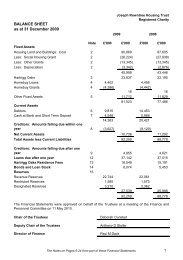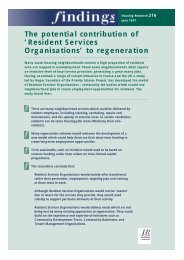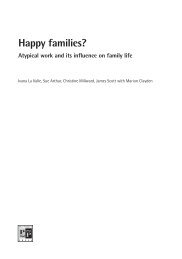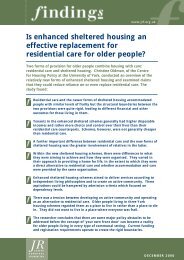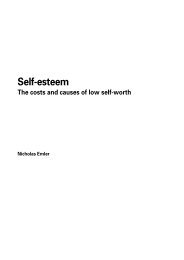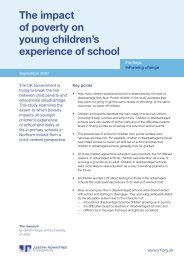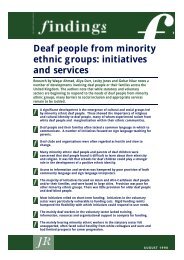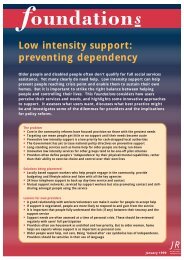Community participation - Joseph Rowntree Foundation
Community participation - Joseph Rowntree Foundation
Community participation - Joseph Rowntree Foundation
You also want an ePaper? Increase the reach of your titles
YUMPU automatically turns print PDFs into web optimized ePapers that Google loves.
Understanding the links between <strong>participation</strong> in governance …<br />
There is no reason to suppose that linking social capital will be<br />
‘distributed evenly or brokered fairly’<br />
The reason why the combination of different types of social capital matters so much<br />
is that the value of social capital, to a citizen, group or whole community, depends on<br />
whether they are able to access and exploit it. In this sense, social capital is a bit like<br />
legal tender – it is valuable at some times and in some places, and not at all valuable<br />
in others. 13<br />
For example, when it comes to community cohesion, it is clear that bridging social<br />
capital needs to be shared among a critical mass of people before it has any real<br />
value – if 500 people of different ethnic backgrounds in an area know one another it<br />
may help to promote good race relations, but if only five do it’s not likely to make<br />
much difference. By contrast, linking social capital is more likely to be embodied in<br />
key relationships between particular individuals or organisations, for example<br />
between the chair of a residents’ association and the housing professionals in the<br />
local authority. 14<br />
Importantly, one of the things that makes social capital, and particularly linking social<br />
capital, valuable to some people is actually the very ability to exclude others from<br />
accessing it. 15 A local authority that wants to work with the community and voluntary<br />
sector, for example, might choose to build good relationships with a few key<br />
organisations by giving them access to a particular forum, or councillor or officer, or<br />
funding regime. 16 But it can only do that if it excludes other organisations from<br />
accessing the same resources. That’s because, if it gives all organisations access to<br />
these resources, then their value diminishes considerably – they become one voice<br />
among many at a forum, one opinion among many for the councillor to weigh up, a<br />
recipient of one very small grant from a funding regime. The crucial point is that, like<br />
any form of capital, social capital ‘is neither brokered equitably nor distributed<br />
evenly’. 17 The value of social capital is often greater where the social networks<br />
connecting participants are relatively closed; sanctions, norms and expectations are<br />
easier to enforce, and trust is greater. 18 But this also leads to divisions between<br />
these ‘insiders’ and ‘outsider’ individuals or groups who cannot benefit from the<br />
social capital that closure creates.<br />
That means we should be wary of thinking that linking social capital will accrue to a<br />
large section of the community. The benefits the wider community derives from<br />
linking social capital depend on the patterns of bonding and bridging social capital<br />
that combine with it – in the example above, through the broader social networks and<br />
ties that the residents’ association has with people in the neighbourhood.<br />
11




